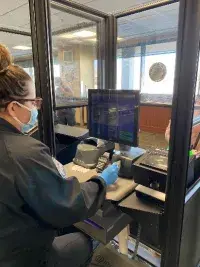
RENO, Nevada - With an anticipated spike in the number of people traveling during the summer months, the Transportation Security Administration (TSA) highlighted its use of new technologies and modified security procedures to help protect the health and safety of travelers departing Reno-Tahoe International Airport (RNO).
TSA is using computed tomography (CT) technology in the security checkpoint at RNO to screen travelers’ carry-on luggage. The CT scanners apply a sophisticated algorithm during the screening process while an X-ray camera shoots hundreds of images while spinning around the conveyor belt, generating a 3-D image of the item being screened. There are two CT scanners in use at RNO.
The 3-D X-ray image can be manipulated on screen to allow for a better view of the bag’s contents, allowing a TSA officer to clear the contents of a bag for security threats without having to manually open it for a bag check. Fewer bag checks is beneficial since it reduces physical contact between the traveler and a TSA officer and speeds up the overall screening process. In addition, travelers can leave everything in their carry-on bag, including electronics and food, when it is screened through a CT scanner.
TSA is also using Credential Authentication Technology (CAT) at RNO. These units are able to confirm the validity of a traveler’s photo identification and confirm flight information in near real time. When travelers approach the travel document checking podium and CAT is in use, they need to hand over their photo identification only to the TSA officer. There is no need to show a boarding pass. CAT units are also able to identify fraudulent documents and those that have been tampered with.
Over the past several months, TSA has modified its procedures as part of its “Stay Healthy. Stay Secure.” campaign. Travelers departing RNO and airports across the country can expect to see:
• All security officers wearing face masks and gloves during the screening process. Security officers will change their gloves after each screening position rotation, after a pat-down or upon a passenger’s request.
• All travelers wearing a mask in the airport and at TSA airport screening checkpoints. The federal requirement to wear a mask has been extended until September 13, 2021. Face coverings need to cover the nose and mouth and fit snugly against the sides of the face without gaps. A TSA officer will ask travelers to briefly adjust their mask for ID verification purposes. Travelers without a mask may be denied entry, boarding, or continued transport. Failure to comply with the mask requirement can result in civil penalties.
• Social distancing leading up to and in the security checkpoint environment.
• Increased frequency and intensity of cleaning and disinfecting surfaces in the security checkpoint including bins. This is no substitute for practicing good hygiene while traveling. Travelers are encouraged to wash their hands before and after going through the checkpoint.
Here are some additional tips to remember during the summer travel season:
Step 1: Pack smart
Travelers should be aware of the contents of their carry-on bags and make sure they are not bringing prohibited items to the security checkpoint. To determine whether an item is allowed or prohibited in carry-on luggage, download the MyTSA app and use the “Can I Bring?” feature. By planning ahead, travelers can avoid a bag check and reduce the potential for cross-contamination. Another option is to contact @AskTSA on Twitter or Facebook Messenger to get answers to your travel questions.
Step 2: Secure items in your carry-on
When removing items from pockets such as phones, keys or loose change, travelers should secure them in their carry-on bags instead of placing them in bins. Avoid placing personal items in bins since those are a common use item and should be treated as such.
Step 3: Traveling with hand sanitizer
TSA is allowing one liquid hand sanitizer container, up to 12 ounces per passenger, in carry-on bags. Passengers may also bring hand wipes of any size or quantity through security checkpoints.
Step 4: Enroll in TSA PreCheck®
People can “Travel with Ease” and experience a smoother screening process by enrolling in TSA PreCheck®. Eligible travelers do not need to remove shoes, belts, light outerwear, laptops, electronics larger than a cell phone or travel-size liquids from carry-on luggage. There is an enrollment center located at RNO near the ticket counters. In April 2021, 98% of travelers eligible for TSA PreCheck waited five minutes or less to be screened at airports nationwide. Another benefit of the program is that children 12 and under are permitted to use the TSA PreCheck lane when traveling with an eligible parent or guardian on the same itinerary.
TSA reminds travelers that as the number of people traveling continues to increase, please arrive two hours prior to flight departure. This will allow plenty of time to complete all steps of the travel process from curb to gate.

